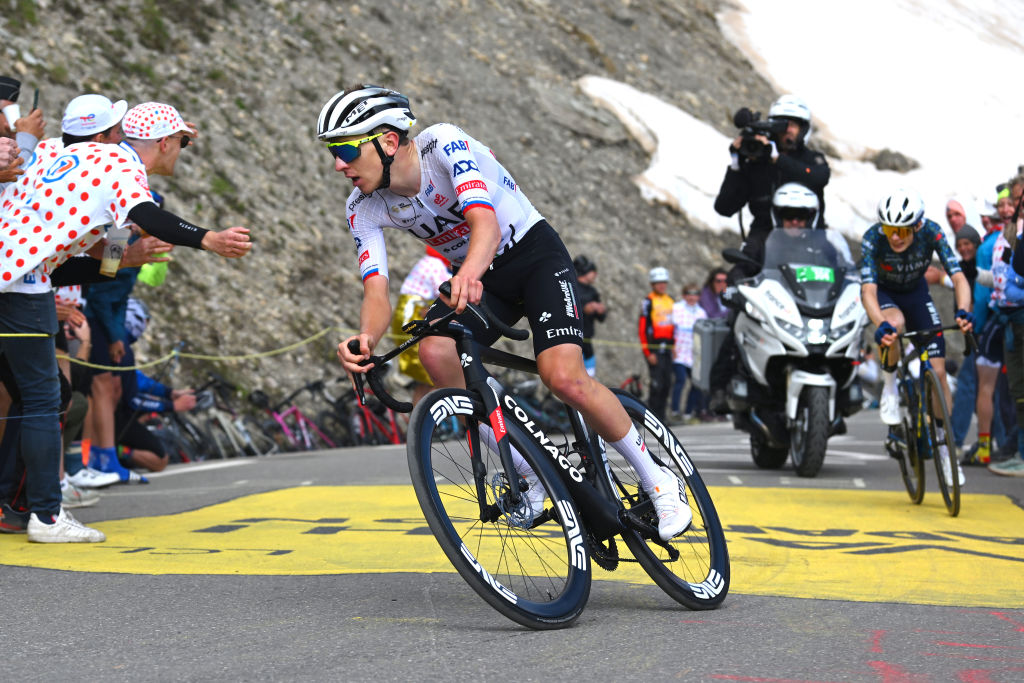
The pessimism expressed by many before the peloton rolled out of Florence has thankfully failed to materialise, and it looks increasingly likely that the 111th edition of the Tour de France is not going to be the dull procession many had predicted.
Even better for the French, who again have no overall contender, they haven’t had to endure days of agony wondering if one of the homegrown riders was going to be victorious. That first yellow jersey for Romain Bardet was just what was needed to perk up interest in the event and Kévin Vauquelin’s victory the following day added to the realisation that a Grand Départ on foreign soil isn’t such a bad thing after all.
The breakaway’s survival to the line on the opening stages proved that the race isn’t necessarily going to controllable to the nth degree by one or two teams who are hoping for a victory on a given day.
DSM-Firmenich-PostNL’s success with Bardet and Frank van den Broek riding their hearts out was one of those joyous moments that reminded everyone that, even in these days of information overload, the plucky attackers sometimes triumph. Bardet’s decision to give up his GC ambitions and ride for stage victories instead is much more in keeping with the ethos of how the Dutch team has raced in the past.
It was more surprising the following day, with an Arkéa-B&B Hotels rider winning when it was meant to be a GC showdown on the San Luca climb. Even though Vauquelin came close to a big breakthrough with second at Flèche Wallonne earlier this year, nobody could have predicted that the guys in the escape could hold off the peloton for the second day running when there was potential to gain a few seconds and, in the process, establish an early hierarchy.
Of course, the overall favourites still poked at each other, and we saw a brutal acceleration from Tadej Pogačar that only Jonas Vingegaard could follow. Cautiously waiting to recover before aiding Pogačar was the right thing for Vingegaard to do, but being able to be up there in the first place was a revelation. Pogačar went into the race lead, but the return of Remco Evenepoel and Richard Carapaz indicated that not everyone was going to be distanced so easily. Primož Roglič and Carlos Rodriguez lost a few seconds, but that were unlikely to be fatal to their ambitions either.
Day three brought the first chance for a proper bunch sprint amid speculation that UAE Team Emirates would quite like not to be responsible for the race lead and that Pogačar would prefer some recovery time to podium duty. With four riders equal on time, EF Education-EasyPost’s plan to put Carapaz in yellow worked out perfectly, though it must have been scary for the Ecuadorian to be involved in the hustle and bustle of a Tour bunch sprint. In some ways, he was helped by the usual crash that happens on these first few skirmishes between the fast men. It was also the perfect excuse for Pogačar, Evenepoel and Roglič to limit their stress with climbing on the menu the next day.
I was briefly in two minds about whether Bardet taking yellow had more of an impact than Binian Girmay finally taking a Tour stage win. Although the DSM rider is very popular, the image of Girmay with his hands aloft in front of the pack is one that has global reach. The importance of the Eritrean’s success can’t be underestimated. This is the biggest event in cycling and the exposure for a rider and team is immense. That a black athlete from the African continent is prominent in what has traditionally been a sport dominated by white Europeans will hopefully bring more diversity into an already international peloton.

Galibier
The Galibier delivered a hierarchy as it quite often does. I don’t think we ought to be surprised by the UAE Team Emirates results on the road to Valloire. The continuation of the annus horribilis for defending champions Visma-Lease a Bike has meant they don’t have the resources in the high mountains to properly support Jonas Vingegaard.
Matteo Jorgensen will do his best, but the Tour is another level up from races like Paris-Nice and the Dauphiné, so the loss of Sepp Kuss just before the start was always going to compromise their strategy. Red Bull-Bora-Hansgrohe, the other expected GC team, are missing something too. Roglič isn’t as sharp as he would like to be, and his lieutenants Aleksandr Vlasov and Jai Hindley aren’t at their peak either. Unless there’s going to be a turnaround in the middle week, that’s likely to leave Roglič exposed to watching those around him.
Thankfully, Mikel Landa hasn’t had his usual slow Grand Tour start and he hasn’t been in any crashes or splits, and so Remco Evenepoel has had a reassuring presence beside him when climbing prowess is required. We’ll have to see if that continues for Landa, but it’s almost worth the Basque rider not riding the coming time trial at his maximum to conserve energy for later on.
In any case, Tadej Pogačar seized his chance after an epic demonstration from his team of how to ride a short mountain stage when you have the strongest rider in the race. Again, only Vingegaard had the capacity to react and, though he couldn’t quite reach his rival’s slipstream, it does at least show he is at a level not far from his best. A remarkable recovery when you realise a few months ago he was very badly injured and that this is his first race since April.
In the space of that last 500 metres of the Galibier, I think we saw the current state of play for everyone in that front group. Pogačar is as good as he was at the Giro. Evenepoel and Vingegaard are similar though their climbing characteristics differ. And then you have Carlos Rodriguez and Juan Ayuso, with Roglič dangling on the back.
The way UAE used up their riders showed they understood the strategic parts of the last climb, particularly the wind direction. They knew where to ride hard so very few had shelter, and they knew where to accelerate, thus adding to the difficulty of staying in the group. It may have been part of the plan to employ Adam Yates earlier than usual, at 5km from the summit, and it was certainly effective in distancing many contenders, but the main damage was done by João Almeida and later by Juan Ayuso.
I didn’t read too much into Almeida calling Ayuso up to the front in the last kilometres of the Galibier. It was more likely that Ayuso simply was pinned in position while the Portuguese rider powered away when Yates had done his work. Nobody who found themselves in the gutter at that point looked really comfortable.
Interestingly, Evenepoel looked the least comfortable on the descent to the finish and from having done it at that kind of speed I’m not that surprised if, as the Belgian stated, he had a few scares near the top and his confidence took a temporary knock. Those first few hairpins with snowmelt running across the surface aren’t that comfortable and then the long straights further down are properly rapid. You need your wits about you and if you’ve lost a few of them further up, then it takes a while to regain composure.
The next few days will see a return to the cat and mouse game between the inevitable breakaways and the sprinters’ teams. It’s unlikely that Pogačar will be able to relinquish the race lead like he did on stage 3. But he has the knowledge that his squad is the strongest in the race and now he has to stay relatively quiet until the time trial and the gravel of the Troyes stage. Being in yellow will allow a bit more respect from the sprinters, although when it’s properly hectic even that goes out the window.
Finally, there’s Mark Cavendish watch. He’s mostly been suffering up until now so how much more happiness could the Tour give if he appears near the front in the coming days? A lot, and we’ve already been spoiled so far.
Get unlimited access to all of our coverage of the Tour de France - including breaking news and analysis reported by our journalists on the ground from every stage of the race as it happens and more. Find out more.







